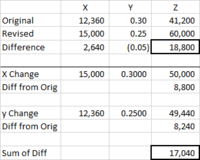pawlowski6132
New member
- Joined
- Nov 18, 2020
- Messages
- 7
OK, I'be been pounding my head against the wall all morning to trying to figure this out.
This is a real world problem.
1. I have an equation such that X divided by Y = Z.
2. Then, X and Y change at the same time.
3. The difference in Z between Original and Revised in this example is 18,800.
4. I'd like to explain or "break down" the 18,800 in terms of X and Y. "I.e, Of the 18,800, ____ was due to change in X and ____ was due to change in Y."
5. I thought I could understand the impact from each variable by changing one at a time and then add their impact but, it's not equal to changing both at once.
6. How can I quantify the "contribution" that X and Y made discreetly to 18,800??????

This is a real world problem.
1. I have an equation such that X divided by Y = Z.
2. Then, X and Y change at the same time.
3. The difference in Z between Original and Revised in this example is 18,800.
4. I'd like to explain or "break down" the 18,800 in terms of X and Y. "I.e, Of the 18,800, ____ was due to change in X and ____ was due to change in Y."
5. I thought I could understand the impact from each variable by changing one at a time and then add their impact but, it's not equal to changing both at once.
6. How can I quantify the "contribution" that X and Y made discreetly to 18,800??????

